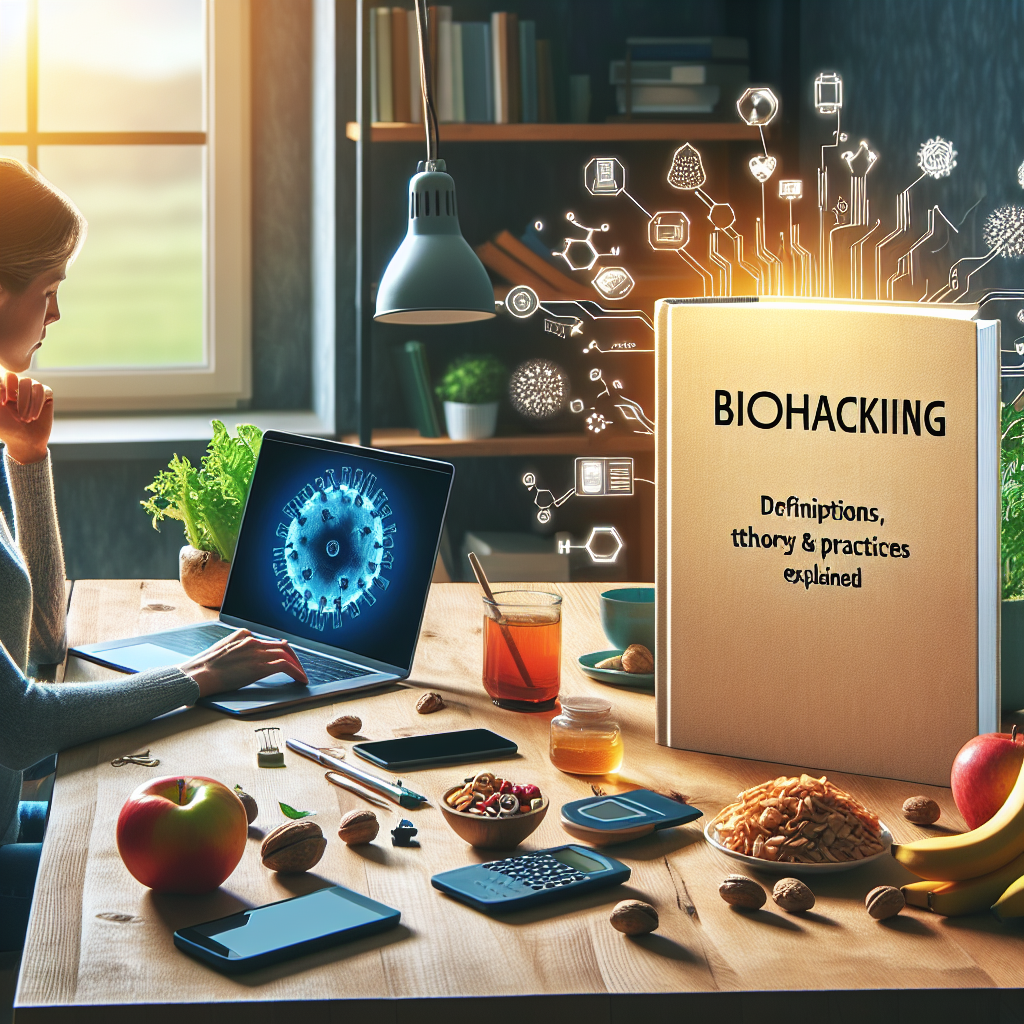
Unlocking the Potential of Biohacking
Imagine having the power to enhance your body and mind, not in the distant future, but right now. That’s the promise of biohacking, a revolutionary approach to personal health that combines the latest in technology, biology, and self-experimentation. It’s about taking control of your own biology to live healthier, more vibrant lives. Let’s embark on this journey together, unlocking the secrets to optimized living.
Key Takeaways: Article-at-a-Glance
- Biohacking is the practice of modifying our biology with technology and lifestyle changes to enhance our body’s performance.
- It’s a broad field that includes everything from dietary changes to implantable devices.
- Understanding the theories behind biohacking can help us make informed decisions about our health.
- DIY biology and grassroots innovation play a significant role in the biohacking community.
- It’s important to distinguish between the myths and realities of biohacking to practice it safely and effectively.
What Exactly Is Biohacking?
At its core, biohacking is about self-improvement. It’s a proactive approach to making changes to your lifestyle and body in order to improve your health and well-being. Whether it’s tweaking your diet to achieve better mental clarity or using gadgets that track your sleep patterns, biohacking is about making small, incremental changes that lead to significant improvements in your life.
The Basic Concept
Biohacking might sound like something out of a sci-fi novel, but it’s actually grounded in the idea that we can control our own biology. At its simplest, it involves making lifestyle changes that support our body’s natural processes. For some, this might mean adopting a ketogenic diet to fuel the brain more efficiently. For others, it could involve using meditation to reduce stress. It’s all about finding what works for you.
Take James, for example. He started tracking his sleep with a wearable device and realized he was only getting 5 hours of quality sleep a night. By adjusting his bedtime routine and environment, he increased this to 7 hours, leading to better focus and productivity during the day.
These tweaks are just the tip of the iceberg. As we explore further, you’ll see that biohacking encompasses a wide range of practices, from the simple to the complex.
Myths vs. Realities
There’s a lot of buzz around biohacking, and with any buzz comes myths. Some think it’s about turning into a cyborg or searching for immortality. The reality is much more practical. Biohacking is about optimizing your current state of living. It’s not about rejecting modern medicine but enhancing it with additional, personalized practices.
It’s crucial to approach biohacking with a critical eye. Not all hacks are created equal, and what works for one person may not work for another. The key is to use evidence-based practices and listen to your body.
Exploring the Theories Behind Biohacking
Why do we biohack? It’s not just about the physical benefits. There’s a whole philosophy behind the practice. Biohackers often share a belief in self-empowerment and a desire to push the boundaries of what’s possible. They’re not content to accept the status quo of their health and are always looking for ways to improve it.
The Roots of Biohacking
The roots of biohacking are deeply entwined with the human desire for betterment and self-actualization. It’s a modern manifestation of the age-old quest for longevity and vitality. But unlike the elusive Fountain of Youth, biohacking is based on real science and accessible technology.
From the early days of experimenting with diets to the latest in genetic editing, biohacking has always been about pushing the limits of human potential. It’s about taking the science of life—biology—and applying a hacker’s mindset to it: testing, tweaking, and optimizing.
DIY Biology and Grassroots Innovation
One of the most exciting aspects of biohacking is its grassroots nature. DIY biology is at the heart of the movement, with individuals and communities taking an active role in their health. This isn’t about waiting for a doctor’s prescription; it’s about taking the initiative to research, experiment, and share findings.
Community labs and online forums have sprung up around the world, democratizing access to biohacking knowledge and tools. These spaces are incubators for innovation, where citizen scientists can explore biology without the constraints of traditional academia or industry.
In these communities, you’ll find a vibrant mix of enthusiasts, from software developers to students, all united by a shared passion for exploration and self-improvement. It’s a testament to the power of collaboration and open-source thinking.
The Biohacking Mindset
Adopting the biohacking mindset means embracing curiosity and a willingness to experiment. It’s about personal empowerment and taking an active role in your health. Biohackers don’t just passively accept medical advice; they seek to understand their bodies and make informed decisions.
It’s a mindset that values data and personal experience. By tracking and analyzing everything from sleep patterns to blood glucose levels, biohackers gain insights into their unique physiology. This self-knowledge is then used to make targeted interventions, leading to improved health outcomes.
Ultimately, the biohacking mindset is about resilience and adaptability—qualities that are essential in an ever-changing world.
Hacking Versus Traditional Science
While traditional science often moves at a deliberate pace, biohacking is more agile, mirroring the rapid iteration cycles of the tech industry. This isn’t to say that biohacking lacks rigor; it simply operates on a different scale and timeline.
Traditional science seeks to understand the world through controlled experiments and peer-reviewed studies. Biohacking, on the other hand, is personal. It’s about applying scientific principles to your own life in real-time. The results may be anecdotal rather than universal, but they are no less valuable to the individual.
This hands-on approach doesn’t replace traditional science; it complements it. By taking ownership of our health and experimenting with new techniques, we can all contribute to the collective understanding of human biology.
Embracing a Holistic Approach to Self-Improvement
Biohacking isn’t just about physical health; it’s about a holistic approach to self-improvement. It recognizes that our minds and bodies are interconnected, and that changes in one can lead to improvements in the other.
It’s about balance. Sleep, nutrition, exercise, stress management, and mental health are all pieces of the puzzle. By looking at the big picture, biohackers can find synergies that lead to greater overall well-being.
Embracing this holistic approach means recognizing that there are no magic bullets. True health is the result of consistent, mindful choices and a commitment to ongoing self-discovery.
Practical Biohacking Techniques
Now that we’ve covered the mindset and philosophy, let’s get into the practical techniques you can start using today. These are actionable strategies that have helped many improve their health and performance.
Dietary Interventions for Enhanced Living
What you eat has a profound impact on your health, and biohackers take this to heart. Dietary interventions are among the most popular and effective biohacks. They can lead to improved energy levels, better cognitive function, and a healthier body composition.
Ketosis and Intermittent Fasting
Ketosis, achieved through a ketogenic diet, is a state where your body burns fat for fuel instead of carbohydrates. This can lead to weight loss, increased energy, and sharper mental focus. Intermittent fasting, which involves cycling between periods of eating and fasting, can also promote fat loss and improve metabolic health.
Both of these dietary strategies harness the body’s natural metabolic flexibility, allowing you to tap into stored energy reserves and optimize performance.
Nutrigenomics: Tailoring Nutrition to Your Genes
Nutrigenomics is the science of how your genes interact with nutrients. It’s a cutting-edge field that allows for personalized nutrition plans based on your DNA. By understanding your genetic predispositions, you can tailor your diet to support your unique biology.
For example, if you have a genetic variation that affects how you metabolize caffeine, you might adjust your coffee intake for optimal energy levels. This level of personalization is the future of nutrition, and it’s a biohack that can make a real difference in how you feel and perform.
Cognitive Upgrades
Enhancing our cognitive abilities is a cornerstone of biohacking. After all, our brains are command centers for everything we do. Whether it’s improving memory, boosting focus, or maintaining mental clarity, biohackers have a variety of tools at their disposal to upgrade their cognitive functions.
The Role of Nootropics
Nootropics, also known as ‘smart drugs’, are substances that can enhance brain performance. They’re a popular biohack for those looking to gain a mental edge. From natural supplements like Ginkgo biloba to synthetic compounds like Modafinil, nootropics come in many forms.
- Caffeine + L-Theanine: A popular combination that balances the stimulant effects of caffeine with the calming effects of L-Theanine.
- Omega-3 Fatty Acids: Essential for brain health, found in fish oil supplements and known to improve cognitive function.
- Racetams: A class of drugs that can enhance memory and neuroprotection.
- Bacopa Monnieri: An herb traditionally used to improve memory and reduce anxiety.
- Lion’s Mane Mushroom: A natural nootropic that supports brain health and neurogenesis.
When it comes to nootropics, it’s crucial to do your research and consult with a healthcare professional, especially when considering synthetic options. The goal is to safely enhance cognitive function without negative side effects.
Meditation as a Biohack
While nootropics can provide a biochemical boost to brain function, meditation offers a no-cost, accessible method to enhance cognitive abilities. Regular meditation practice has been shown to reduce stress, improve concentration, and even increase gray matter density in the brain.
Think of meditation as exercise for your mind. Just as you would lift weights to build muscle, you can use meditation to strengthen your brain’s ability to focus and resist distraction. It’s a simple yet powerful tool that anyone can use.
Tools of the Trade: Biohacking Technologies
Technology plays a vital role in biohacking. With the right tools, we can gather data about our bodies and make informed decisions about our health. Let’s explore some of the technologies that are essential for any biohacker’s toolkit.
Sensors and Self-Tracking Gadgets
In the world of biohacking, knowledge is power. Sensors and self-tracking gadgets provide the data we need to understand our bodies better. They can track everything from heart rate to sleep patterns, giving us insights into our health that we can use to make positive changes.
Wearables: From Fitness Bands to Sleep Monitors
Wearable technology has exploded in popularity, and for good reason. These devices make it easy to monitor various aspects of our health in real-time. Fitness bands can track our physical activity levels, while sleep monitors can provide insights into our sleep quality and patterns.
By wearing these devices, we can get a clearer picture of our daily habits and their effects on our health. This data can be invaluable for making targeted interventions to improve our well-being.
Tracking Apps: Data Analysis for Self-Optimization
But collecting data is only the first step. To truly biohack our health, we need to analyze and interpret this information. That’s where tracking apps come in. These apps take the raw data from our wearables and turn it into actionable insights.
Whether it’s a fitness app that suggests workouts based on our activity levels or a sleep app that helps us find our optimal bedtime, these tools can help us make the small changes that lead to big improvements in our health.
Beyond The Wearable: Emerging Biohacking Devices
As biohacking evolves, so do the tools. Beyond the wearables, there are emerging devices that push the boundaries of what’s possible. These include advanced sensors that can track blood glucose levels without the need for finger-pricking, and even brain-machine interfaces that could one day enhance our cognitive abilities.
These devices represent the cutting edge of biohacking technology. They offer a glimpse into a future where we have even more control over our health and well-being.
Remember, with any biohacking device, it’s important to use them responsibly and understand their limitations. They’re tools to aid in our quest for better health, not magic solutions.
DIY Genetic Testing Kits
Ever wondered what secrets your DNA holds? DIY genetic testing kits are making waves in the biohacking community, allowing anyone to unlock insights about their ancestry, potential health risks, and even fitness predispositions. These kits work by analyzing your genetic code from a simple saliva sample, providing you with a wealth of information that was once accessible only through medical professionals.
Armed with this data, you can make more informed decisions about your diet, exercise, and lifestyle. For instance, if you discover you have a genetic variant that affects how you metabolize certain vitamins, you can adjust your nutrition accordingly. It’s personalized health care at its most accessible.
Neurostimulation Devices
Imagine being able to enhance your brain’s performance at the push of a button. Neurostimulation devices, which use electrical impulses to stimulate brain activity, are turning this into a reality. These devices can potentially help with everything from improving memory to treating depression.
While the science is still emerging, early adopters in the biohacking community are experimenting with these devices to explore their potential. It’s a bold frontier in the quest to optimize our cognitive abilities, but as with all biohacking tools, it’s essential to proceed with caution and proper guidance.
Ethics and Safety in Biohacking
Biohacking opens up a world of possibilities for enhancing our health and lives. However, with great power comes great responsibility. It’s crucial to consider the ethical implications and safety concerns that come with self-experimentation. Let’s navigate these waters to ensure that our biohacking journey is both effective and responsible.
Navigating the Risks of Self-Experimentation
Self-experimentation is at the heart of biohacking. It’s about personal discovery and pushing the boundaries of what’s possible. However, it’s not without risks. From untested supplements to experimental devices, the quest for self-improvement can sometimes lead to unintended consequences.
That’s why it’s critical to approach biohacking with a mindset of caution and research. It’s about finding the balance between curiosity and safety, ensuring that the steps we take to improve ourselves don’t end up causing harm.
Understanding Consent and Personal Accountability
When you embark on a biohacking journey, you’re essentially becoming your own research subject. This means understanding the concept of informed consent and recognizing that you are accountable for the choices you make.
It’s about doing your homework, understanding the potential risks and benefits, and making decisions that are in your best interest. Remember, just because you can do something doesn’t always mean you should.
Recognizing the Limits: When Biohacking Can Go Too Far
There’s a fine line between optimization and obsession. Biohacking can become problematic when it starts to consume your life or when you push your body to extremes without proper oversight.
Recognizing the limits is about listening to your body and respecting its signals. It’s about seeking professional advice when needed and being willing to step back when a particular biohack isn’t serving your well-being.
The Future of Regulation in Biohacking
As biohacking continues to grow in popularity, the question of regulation becomes increasingly important. How do we balance the freedom to experiment with the need to protect individuals from potential harm?
Current Legal Landscape
The legal landscape for biohacking is a patchwork of regulations that vary widely by country and even by state or region. Some biohacking practices, like dietary supplements, are lightly regulated, while others, such as medical devices, are subject to strict oversight.
As the field evolves, we can expect more discussions around the regulation of biohacking activities. The goal will be to foster innovation while ensuring safety and ethical practices. It’s a delicate balance, but one that is crucial for the sustainable growth of biohacking as a force for good in our lives.
Proposed Guidelines and Policies
As biohacking blurs the lines between science, technology, and personal wellness, there’s a growing call for clear guidelines and policies. Experts suggest a framework that encourages innovation while safeguarding public health. These guidelines might include standards for safety testing of biohacking tools, ethical considerations for self-experimentation, and clearer pathways for community-driven research to contribute to the wider scientific knowledge base.
Proposed policies could also involve the creation of advisory boards comprising biohackers, scientists, ethicists, and legal experts to oversee the development of new biohacking practices. Education on biohacking ethics and safety should become a cornerstone of the community, ensuring that every biohacker is equipped with the knowledge to make informed decisions.
FAQs
Is biohacking safe?
Biohacking can be safe when practiced responsibly. It’s important to start with low-risk interventions, such as dietary changes and exercise, before moving on to more advanced techniques. Always do thorough research, consult with health professionals, and consider potential risks. Remember, what works for one person may not work for another, so listen to your body and proceed with caution.
Can anyone become a biohacker?
Absolutely! Biohacking is about taking control of your own biology, and anyone with curiosity and a willingness to learn can start. Begin with simple changes and gradually explore more advanced techniques as you become more comfortable. The biohacking community is inclusive and supportive, offering resources for beginners and experienced biohackers alike.
What are some common biohacking methods?
Common biohacking methods include dietary interventions like intermittent fasting, using nootropics for cognitive enhancement, sleep tracking for better rest, and fitness monitoring to optimize exercise. More advanced methods can involve genetic testing to personalize health strategies and the use of wearable tech to monitor physiological data.
How does biohacking relate to traditional medicine?
Biohacking complements traditional medicine by empowering individuals to take an active role in their health. It encourages a preventative approach, focusing on optimizing wellness before issues arise. Biohacking practices often incorporate scientific research and can lead to personalized health strategies that support conventional medical advice.
What ethical considerations are there in biohacking?
Ethical considerations in biohacking include the potential for self-harm through untested interventions, privacy concerns around personal health data, and the implications of enhancing human capabilities beyond their natural limits. It’s essential to consider the impact of biohacking not just on the individual, but on society as a whole, ensuring that it remains accessible and beneficial for all.
In conclusion, the practice represents a fascinting fusion of technology, science, and personal wellness. It’s a movement that empowers individuals to take control of their health and push the boundaries of human potential. As we navigate the exciting possibilities of biohacking, it’s crucial to maintain a balance between innovation and safety, curiosity and responsibility. By fostering a community grounded in knowledge, ethics, and collaboration, we can ensure that biohacking continues to evolve as a positive force for personal and societal transformation. Remember, the journey to optimized health is a personal one, and with the right approach, anyone can become a biohacker. Embrace the adventure, stay informed, and let’s hack our way to a healthier future.


